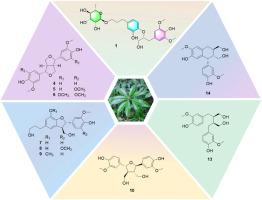台湾梨叶木脂素及其化学分类意义
IF 2
4区 生物学
Q4 BIOCHEMISTRY & MOLECULAR BIOLOGY
引用次数: 0
摘要
对梨叶的植物化学研究分离出16种木脂素(1 - 16),其中包括一种新的木脂素,命名为formolignanoside a(1)。通过光谱数据分析、量子化学计算(13C NMR-DP4+分析和计算ECD)以及与文献数据比较确定其化学结构。所有分离得到的木脂素均为首次从该属植物中分离得到。其中木脂素1−3和8−14为新发现的木脂素。Formolignanoside A(1)是一种潜在的化学分类标记。本研究丰富了台湾凤梨属植物的化学多样性,为凤梨属植物的化学分类研究提供了有价值的信息。本文章由计算机程序翻译,如有差异,请以英文原文为准。

Lignans from the leaves of Pieris formosa and their chemotaxonomic significance
Phytochemical investigation of the leaves of Pieris formosa led to the isolation of sixteen lignans (1–16), including a new lignan named formolignanoside A (1). Their chemical structures were determined by spectroscopic data analysis, quantum chemical calculations (13C NMR-DP4+ analysis and calculated ECD), and comparison with literature data. All the isolated lignans were reported from the genus Pieris for the first time. Among them, lignans 1−3 and 8−14 were newly identified in the Ericaceae family. Formolignanoside A (1) is a potential as a chemotaxonomic marker for P. formosa. This study enriched the chemical diversity of P. formosa and provided valuable information for chemotaxonomic significance on the genus Pieris.
求助全文
通过发布文献求助,成功后即可免费获取论文全文。
去求助
来源期刊

Biochemical Systematics and Ecology
生物-进化生物学
CiteScore
3.00
自引率
12.50%
发文量
147
审稿时长
43 days
期刊介绍:
Biochemical Systematics and Ecology is devoted to the publication of original papers and reviews, both submitted and invited, in two subject areas: I) the application of biochemistry to problems relating to systematic biology of organisms (biochemical systematics); II) the role of biochemistry in interactions between organisms or between an organism and its environment (biochemical ecology).
In the Biochemical Systematics subject area, comparative studies of the distribution of (secondary) metabolites within a wider taxon (e.g. genus or family) are welcome. Comparative studies, encompassing multiple accessions of each of the taxa within their distribution are particularly encouraged. Welcome are also studies combining classical chemosystematic studies (such as comparative HPLC-MS or GC-MS investigations) with (macro-) molecular phylogenetic studies. Studies that involve the comparative use of compounds to help differentiate among species such as adulterants or substitutes that illustrate the applied use of chemosystematics are welcome. In contrast, studies solely employing macromolecular phylogenetic techniques (gene sequences, RAPD studies etc.) will be considered out of scope. Discouraged are manuscripts that report known or new compounds from a single source taxon without addressing a systematic hypothesis. Also considered out of scope are studies using outdated and hard to reproduce macromolecular techniques such as RAPDs in combination with standard chemosystematic techniques such as GC-FID and GC-MS.
 求助内容:
求助内容: 应助结果提醒方式:
应助结果提醒方式:


